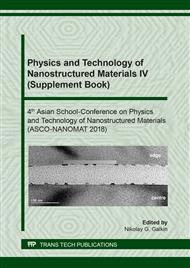[1]
P. Budrugeac, E. Segal, Application of isoconversional and multivariate non-linear regression methods for evaluation of the degradation mechanism and kinetic parameters of an epoxy resin, Polym. Degrad. Stab. 93 (2008) 1073–1080.
DOI: 10.1016/j.polymdegradstab.2008.03.017
Google Scholar
[2]
H.H.P. Yiu, M.A. Keane, Z.A.D. Lethbridge, M.R. Lees, A.J. El Haj, J. Dobson, Synthesis of novel magnetic iron metal–silica (Fe–SBA-15) and magnetite–silica (Fe 3 O 4 –SBA-15) nanocomposites with a high iron content using temperature-programed reduction, Nanotechnology. 19 (2008) 255606.
DOI: 10.1088/0957-4484/19/25/255606
Google Scholar
[3]
R.P. Mogorosi, N. Fischer, M. Claeys, E. van Steen, Strong-metal–support interaction by molecular design: Fe–silicate interactions in Fischer–Tropsch catalysts, J. Catal. 289 (2012) 140–150.
DOI: 10.1016/j.jcat.2012.02.002
Google Scholar
[4]
A.S. Portnyagin, A.P. Golikov, V.A. Drozd, V.A. Avramenko, An alternative approach to kinetic analysis of temperature-programmed reaction data, RSC Adv. 8 (2018) 3286–3295.
DOI: 10.1039/c7ra09848k
Google Scholar
[5]
S. Vyazovkin, A time to search: Finding the meaning of variable activation energy, Phys. Chem. Chem. Phys. 18 (2016) 18643–18656.
DOI: 10.1039/c6cp02491b
Google Scholar
[6]
M.E. Brown, A.K. Galwey, The significance of compensation effects" appearing in data published in "computational aspects of kinetic analysis,: ICTAC project, 2000, Thermochim. Acta. 387 (2002) 173–183.
DOI: 10.1016/S0040-6031(01)00841-3
Google Scholar
[7]
N. Koga, A review of the mutual dependence of Arrhenius parameters evaluated by the thermoanalytical study of solid-state reactions: The kinetic compensation effect, Thermochim. Acta. 244 (1994) 1–20.
DOI: 10.1016/0040-6031(94)80202-5
Google Scholar
[8]
W.K. Jozwiak, E. Kaczmarek, T.P. Maniecki, W. Ignaczak, W. Maniukiewicz, Reduction behavior of iron oxides in hydrogen and carbon monoxide atmospheres, Appl. Catal. A Gen. 326 (2007) 17–27.
DOI: 10.1016/j.apcata.2007.03.021
Google Scholar
[9]
A. Pineau, N. Kanari, I. Gaballah, Kinetics of reduction of iron oxides by H2, Thermochim. Acta. 456 (2007) 75–88.
DOI: 10.1016/j.tca.2007.01.014
Google Scholar
[10]
S. Vyazovkin, K. Chrissa, M. Laura, D. Lorenzo, N. Koga, M. Pijolat, B. Roduit, N. Sbirrazzuoli, J. Josep, Thermochimica Acta ICTAC Kinetics Committee recommendations for collecting experimental thermal analysis data for kinetic computations, 590 (2014) 1–23.
DOI: 10.1016/j.tca.2014.05.036
Google Scholar


